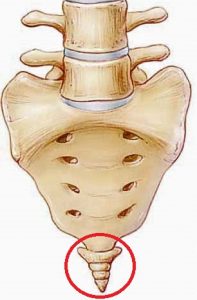
Misalignment of pelvis causes tailbone pain
Two weeks after the birth of her baby in mid-May of this year, 34-year-old Miss Chen found that her pelvis and coccyx were constantly aching. When she sat down, her coccyx pain worsened, and the pain only subsided slightly when she was lying down.
Miss Chen is breastfeeding, and her gynecologist gave her pain killer medication. However, after three weeks of taking the medicine and physical therapy, there is no improvement, after four weeks, the pain of the tailbone not only does not disappear, but slowly radiate to hips. The patient came to see the author in July. After examination, it was found that Ms. Chen’s coccyx may be misaligned and inflamed due to excessive force during childbirth, and the pelvis has misalignment due to the loosen ligaments after pregnancy. The lower back muscles were too tight. After several pelvic adjustment and the condition of coccyx was completely improved after treatment.
The structure of the tailbone (Figure 1)

The coccyx is located at the very end of the spine, so it is called the coccyx. The coccyx is composed of three to five vertebrae, which are shaped like a triangle with the pointed end facing downward.
The coccyx is connected to the tail of the sacrum by ligaments. When we walk or bend over, the coccyx will not move much, but when sitting down, the coccyx will be pushed inward by about 22 degrees, so the sitting posture will often affect the coccyx degree of stress. (Figure II)

Incorrect posture Correct posture
Causes of tailbone pain
Coccyalgia usually occurs after accidental injury, fall, pregnant woman giving birth or repetitive coccygeal strain. The patients are usually female, which may be due to the unique pelvic structure of females, and the curvature of the tailbone is slightly outward. In addition, because the bone ligament is relatively loose after pregnancy, the coccyx is prone to be pushed out and shifted during delivery, causing pain. Some people with long tailbone and forward structure are more likely to have tailbone pain after pregnancy.
Clinical symptoms of coccygeal pain
Patients with coccygeal pain usually feel pain after sitting or sitting for a long time. The degree of pain depends on the softness of the seat or the length of time sitting. The patient will feel a tingling sensation in the tailbone, and the area around the tailbone. When you gently press the tailbone with your fingers, you will feel very tingling, and sometimes the pain even extends to the legs. Some people have particularly painful tailbone during bowel movements or menstrual cramps in women. In this case, if the patient sits down and often applies force to the one side, the pelvic bone will press on the nerves, causing pain and numbness.
Treatment of tailbone pain
The normal tailbone is slightly bent forward, but when a fall is injured or some pregnant women give birth, the tailbone will misaligned, causing the surrounding soft tissues and ligaments to tighten and cause pain. The misalignment of the tailbone can be seen on the X-ray, which may be bending forward, shifting to the left or right. After a detailed examination, the chiropractor will know the extent of the tailbone misalignment and the location of the injury. Chiropractors will use electrotherapy, ultrasound and laser to relieve soft tissue inflammation and pain, and then use a special instrument (Activator) to correct the misalignment of the coccyx (due to the position of the coccyx, it cannot be corrected with hand). After correcting the misaligned pelvis with manual techniques, the patient generally feels significant progress after 10 treatments, which greatly reduces the pain of the coccyx and pelvis when sitting.

 Book an Appointment
Book an Appointment


